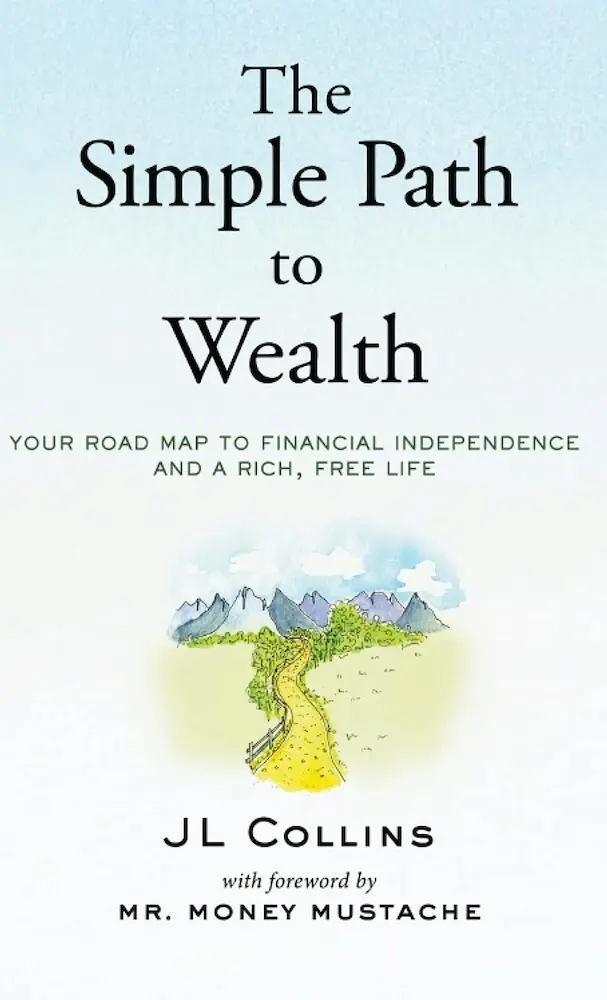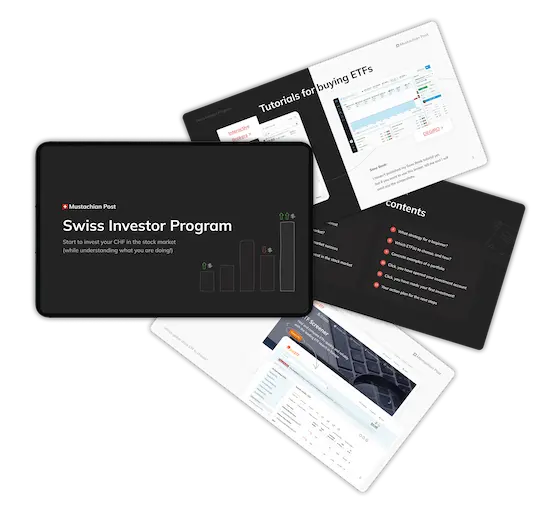When I wanted to start investing in the stock market from Switzerland, I studied all the passive investment strategies: blue chip portfolios, 3-fund Bogleheads portfolios 1, lazy portfolios, stock picking, and so on.
After extensive research in 2014, I started with a portfolio of ETFs composed mainly of Swiss stocks and bonds ETFs and… global stocks ETFs in “CHF hedged” mode…
Rereading these lines, I think I’ve come a long way…
At one point, I even wondered whether I shouldn’t invest in specialized ETFs. Short answer: no!
Lots of choices… and too few answers…
Then in 2016, I ended up adopting the Bogleheads strategy, simple and effective: your age as a percentage of bonds, and the rest in stocks (one part in world stocks and the other in Swiss stocks).
But the more the years went by, the more something bothered me.
After several readings, I decided to switch to 100% stocks for the rest of my life.
My investment portfolio before: Bogleheads
After much procrastination and feedback from readers in the know about stock market investing, I set out with a three-fund Bogleheads portfolio in 2016.
The Bogleheads strategy is based on a simple allocation: your age = bonds part, the rest in stocks.
For example, at 35: 35% bonds, 65% stocks.
The idea behind such an allocation is to be aggressive with lots of stocks (aka equities) when you’re young and in the money accumulation phase, and to have less volatility as you get older when your income may decline with retirement.
What I liked
- Simplicity (~15 min per quarter)
- Proven effectiveness over the long term for a “lambda” investor like me (as a strategy based on index funds in the form of ETFs)
- Easy to understand (your age as a percentage of bonds, and the rest in stocks)
- Less volatility (compared to 100% stocks)
What bothered me
- Overall return limited by bonds
- Share-bond correlation less and less effective due to persistently low interest rates (bonds no longer really play their role as a cushion in the event of a crash)
- Lack of coherence with my long-term FIRE vision (the older I get, the more the Bogleheads strategy pushes me to reduce risk, whereas I intend to invest for decades to come, even once I’m financially independent, and that I certainly intend to make money with my personal projects and other real estate investments).
In short, my typical Bogleheads allocation of “65% stocks and 35% bonds” provided stability and reassurance, but frustrated me by seeing some of my “sleeping” cash lying around in bonds.
N.B. I should rather say that the closer I got to actually investing in bonds (because until then, my second pillar already covered the bond portion), the less I could get used to the idea of leaving money sitting in a bond ETF…
The trigger for my new investment strategy
My mind changed after reading one book in particular: “The Simple Path to Wealth” by JL Collins 2:
And this video “The Most Controversial Paper in Finance” by Ben Felix also impacted my choice:
JL Collins’ logic is crystal clear: bonds don’t protect you from the real risk, which is missing the opportunity for more yield over 30 or even 40 years.
Also, age matters less than the FI phase you’re in (accumulation or consumption of wealth). Because if you’re working until 55 by choice, then you’re going to want to put all your savings to work in stocks as much as possible, knowing that you’re still earning cash (in salary). There’s no need to have more than 50% in bonds in this period!
Regarding Ben Felix and the economic paper “Beyond the Status Quo: A Critical Assessment of Lifecycle Investment Advice”, in a nutshell:
- If you accept the ups and downs of the stock market (aka stock market volatility)
- AND if you understand that the market doesn’t always reflect the true value of companies
- AND if you also understand that the global market always goes up because ETFs are self-cleaning (bad stocks come out of the indices mechanically AND automatically, and are replaced by better companies)
- => then, you’ll want to get the maximum possible return… with a 100% stocks portfolio!
In short: there was no longer any reason for me to remain restricted.
My investment portfolio now: 100% stocks
So I chose a 100% stock allocation, ultra-simple and consistent.
My current portfolio
| Assets | Ticker | Share |
|---|---|---|
| ETF World | VT-Vanguard Total World Stock ETF | 100% |
Why this choice
- Superior performance over the long term
- Total simplicity: a single ETF, no rebalancing
- Psychological alignment with the level of risk that I can support
- Less fees, fewer products, more freedom
What I assume
- Higher volatility
- Sharper corrections (-50 to -55% in the event of a major crisis 3, versus -20 to -35% with bonds in the portfolio)
- Full confidence and positivism in global growth, despite all the events along the way
Bonds can be good
A quick reminder of what a bond is, if you’re new to the blog: it’s a loan to a country or a company. And so, by definition, it’s a risk too (loss, in the event of default by the borrower). On the other hand, it’s actually less volatile than stocks, because the income (interest) is known in advance, and prices move much less on a daily basis.
The older you get, the harder it can be to say to yourself “I’ll find a job again easily if the stock market falls” (although we Mustachians will always be active in one way or another until we die).
So yes, in that phase, bonds can play a role. But not for the yield, no, just to sleep easy if you’re really running out of cash.
But until then, I’d rather rely on Mustachian creativity and resourcefulness than on bonds with low (or even negative…) interest rates.
The philosophy behind this portfolio change
This is not an impulsive decision, but a logical evolution.
Over the years, I’ve come to understand that:
- The “reassuring” diversification of bonds is of little use once you’ve got your emotions under control
- The real danger comes from inaction, not volatility
- Time and consistency beat any complex strategy
As Warren Buffett sums up in his 2024 annual letter to shareholders: “Berkshire will never prefer ownership of cash-equivalent assets over the ownership of good businesses.” In other words: cash protects, but doesn’t grow your wealth.
And that’s exactly what I’ve come to realize: as long as I can sleep soundly with volatility, I might as well let 100% of my money work in productive markets.
In other words: 100% stocks, 100% confidence, 0% complexity.
And what about the 2nd pillar in all this?
A small detail that is often overlooked: when you build your wealth in Switzerland, your 2nd pillar acts in part as the bond component of your assets, as it is invested conservatively, generally with a low proportion of equities (often between 25 and 30% depending on the pension fund).
You pay a portion of your salary into it every month, and this money is invested in an ultra-conservative manner.
In other words, even if your personal portfolio is 100% stocks, your overall wealth is not.
This “forced” 2nd pillar already creates a natural balance in your asset allocation, without you having to hold bonds yourself in your securities account.
Aside: once I reach FI, I will transfer my entire second pillar to the best vested benefits account, choosing a 100% global stocks strategy. So yes, as I get older, I will further increase our risk profile to maximize our returns.
And no more SMIM ETFs (Swiss stocks) either!?
No more SMIM, exactly.
The SMIM, which groups the 30 largest medium-sized Swiss companies (aka mid-caps, situated between small SMEs and SMI giants like Nestlé, Roche or Novartis), weighs next to nothing on a global scale.
To give you an idea: the entire Swiss market (SPI) represents around 2% of the world’s market capitalization, and the SMI only 5% of this 2%, or barely 0.1% of the world’s total.
In other words, in a global portfolio like VT, the “natural” share of Swiss mid-caps is virtually nil.
Putting 10% of your portfolio in them is like overweighting them by around ×100 compared to their real weight in the world.
And the Swiss market is:
- very small (only a few dozen listed companies)
- highly concentrated (Nestlé, Roche, and Novartis account for over 50% of the SMI)
- not that much diversified by sector (industrials, healthcare, consumer goods, financials)
So, rather than “correct” this bias with yet more Swiss, I opted for absolute simplicity:
100% global stocks via VT, and basta.
I already have enough CHF in my real life (income, cash, repayments); no need to add more in my investments.
And when I’m FI (= financially independent), I’ll simply keep a CHF cash reserve of about 1 year’s expenses to cover short-term needs.
This makes more sense than artificially overweighting the Swiss market, which would only increase risk without offering any significant advantages, in my opinion.
I am aware that I am losing a little in terms of currency hedging and tax advantages on Swiss dividends, but in the long term, these differences remain marginal compared to the gains in simplicity and consistency.
What does that mean for your portfolio?
Perhaps you’re still at the “Bogleheads strategy” stage, or already tempted by “full stocks”.
No matter what: the important thing is to understand your horizon, your risk profile and your convictions.
And, above all, to start investing today! (I have this article that may help: How would I invest CHF 10'000 in the stock market if I were starting out today?)
I’ll say it again here: a Bogleheads portfolio is still perfect for many investors. And a thousand times better than a stock picking portfolio.
Ditto: SMIM is not inherently bad. It’s made up of some very fine companies. It’s just that, based on my analysis and understanding of the stock market to date, it no longer makes much sense in my investment portfolio.
Conclusion
Moving to 100% stocks via my global VT ETF is not a leap in the dark; it’s a natural evolution when your horizon exceeds several decades.
Today, I sleep better with a portfolio that’s simple, logical, and aligned with my Mustachian philosophy: fewer products and lower fees, for greater yield and freedom.
And you, are you staying with a Boglehead strategy, or joining the 100% stocks team?
the name “Bogleheads” comes from Jack Bogle, founder of Vanguard and father of index investing, whose online community bogleheads.org promotes the principles of simple, low-cost investing. ↩︎
I had the chance to chat with the author of “The Simple Path to Wealth”. Read my interview with JL Collins, the ‘Godfather’ of the FI movement ↩︎
for example: the FTSE Global All Cap Index, tracked by the VT ETF, lost around 50% of its value during the 2008 financial crisis, before returning to its pre-crisis level in around four to five years. ↩︎







Last updated: November 6, 2025